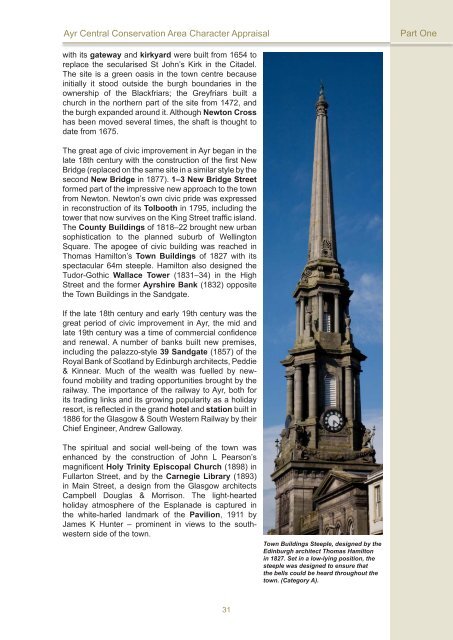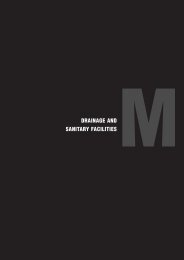Ayr Central Conservation Area Character Appraisal - South Ayrshire ...
Ayr Central Conservation Area Character Appraisal - South Ayrshire ...
Ayr Central Conservation Area Character Appraisal - South Ayrshire ...
Create successful ePaper yourself
Turn your PDF publications into a flip-book with our unique Google optimized e-Paper software.
<strong>Ayr</strong> <strong>Central</strong> <strong>Conservation</strong> <strong>Area</strong> <strong>Character</strong> <strong>Appraisal</strong><br />
Part One<br />
with its gateway and kirkyard were built from 1654 to<br />
replace the secularised St John’s Kirk in the Citadel.<br />
The site is a green oasis in the town centre because<br />
initially it stood outside the burgh boundaries in the<br />
ownership of the Blackfriars; the Greyfriars built a<br />
church in the northern part of the site from 1472, and<br />
the burgh expanded around it. Although Newton Cross<br />
has been moved several times, the shaft is thought to<br />
date from 1675.<br />
The great age of civic improvement in <strong>Ayr</strong> began in the<br />
late 18th century with the construction of the first New<br />
Bridge (replaced on the same site in a similar style by the<br />
second New Bridge in 1877). 1–3 New Bridge Street<br />
formed part of the impressive new approach to the town<br />
from Newton. Newton’s own civic pride was expressed<br />
in reconstruction of its Tolbooth in 1795, including the<br />
tower that now survives on the King Street traffic island.<br />
The County Buildings of 1818–22 brought new urban<br />
sophistication to the planned suburb of Wellington<br />
Square. The apogee of civic building was reached in<br />
Thomas Hamilton’s Town Buildings of 1827 with its<br />
spectacular 64m steeple. Hamilton also designed the<br />
Tudor-Gothic Wallace Tower (1831–34) in the High<br />
Street and the former <strong>Ayr</strong>shire Bank (1832) opposite<br />
the Town Buildings in the Sandgate.<br />
If the late 18th century and early 19th century was the<br />
great period of civic improvement in <strong>Ayr</strong>, the mid and<br />
late 19th century was a time of commercial confidence<br />
and renewal. A number of banks built new premises,<br />
including the palazzo-style 39 Sandgate (1857) of the<br />
Royal Bank of Scotland by Edinburgh architects, Peddie<br />
& Kinnear. Much of the wealth was fuelled by newfound<br />
mobility and trading opportunities brought by the<br />
railway. The importance of the railway to <strong>Ayr</strong>, both for<br />
its trading links and its growing popularity as a holiday<br />
resort, is reflected in the grand hotel and station built in<br />
1886 for the Glasgow & <strong>South</strong> Western Railway by their<br />
Chief Engineer, Andrew Galloway.<br />
The spiritual and social well-being of the town was<br />
enhanced by the construction of John L Pearson’s<br />
magnificent Holy Trinity Episcopal Church (1898) in<br />
Fullarton Street, and by the Carnegie Library (1893)<br />
in Main Street, a design from the Glasgow architects<br />
Campbell Douglas & Morrison. The light-hearted<br />
holiday atmosphere of the Esplanade is captured in<br />
the white-harled landmark of the Pavilion, 1911 by<br />
James K Hunter – prominent in views to the southwestern<br />
side of the town.<br />
Town Buildings Steeple, designed by the<br />
Edinburgh architect Thomas Hamilton<br />
in 1827. Set in a low-lying position, the<br />
steeple was designed to ensure that<br />
the bells could be heard throughout the<br />
town. (Category A).<br />
31

















